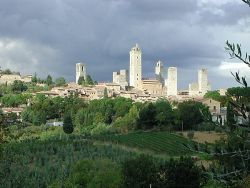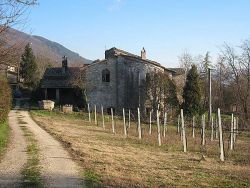San Masseo and Cèllole
We are happy to announce to out friends and guests that last January that last January we have picked another place for the foundation in the near future of a small fraternity, which we wish to be simple and relevant, thanks to the paternal attentiveness of the bishop of Volterra, Alberto Silvani, and of the pastor of Cèllole-Libiano, don Armando Volpi. This is the ancient Romanesque complex of the parish church of Cèllole, situated in the town of San Gimignano, in the province of Siena, in the magnificent landscape of the hills of Valdelsa
While the work of restructuring the Monastery of San Masseo in Assisi, which is to house a fraternity of the Community, is proceeding according to plan, — we hope that the first brothers can go to live there this autumn — we are happy to announce to out friends and guests that last January that last January we have picked another place for the foundation in the near future of a small fraternity, which we wish to be simple and relevant, thanks to the paternal attentiveness of the bishop of Volterra, Alberto Silvani, and of the pastor of Cèllole-Libiano, don Armando Volpi. This is the ancient Romanesque complex of the parish church of Cèllole, situated in the town of San Gimignano, in the province of Siena, in the magnificent landscape of the hills of Valdelsa. The buildings next to the church need repairs of conservation to make them habitable, which we hope to begin as soon as possible.
The first mention of the Romanesque parish church of Cèllole takes us to the times of the undivided Church, to the end of the first millennium. The church, situated on the via Francigena, under the direction of the bishops of Volterra, is mentioned for the first time in two documents dated 949 and 1011, according to which it was dedicated in honor of St John the Baptist. In later documents the church receives the title of Santa Maria Assunta, which it has kept till now. At the end of the twelfth century the parish church complex included also a priest’s residence and a leprosarium. The interior of the church, of great simplicity and clarity of style, at present has a basilical plan with three naves, separated by columns and pillars that hold up arches, giving the whole a luminous harmony. The gabled façade, sober and clear, opens on a lowly grove of cypresses, and all around one’s gaze can roam gently over the Siennese hills in stillness and meditative silence.
It is a place apart, full of memories, of beauty, and of peace, with a small cemetery that rests on the back of the hill. We are grateful to the Lord for the gift he gives us and at the same time we are aware of the great responsibility that it implies.


